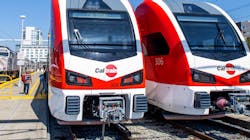Caltrain's Board of Directors unveils proposed electrified service plan
Caltrain's Board of Directors has unveiled the proposed electrified service plan, which includes anticipated service benefits for the Electrification Project slated for completion by fall 2024. The Electrification Project will feature faster trains, less wait time at stations and a simplified schedule.
Proposed service improvements
- Weekday service: Caltrain plans for 104 weekday trains, with four trains per hour per direction during peak times between San Francisco and San Jose.
- The express trains are anticipated to be about an hour between San Francisco and San Jose, with significant expansion of the number of stations that receive express service.
- Local trains would stop at every station and would reduce travel time from San Francisco to San Jose by 25 minutes compared to the current local schedule.
- Both express and local options provide a compelling alternative to Highway 101 as road traffic escalates.
- Weekend service: Subject to additional financial analysis and budget confirmation, Caltrain expects to offer service every 30 minutes, minimizing wait times for weekend customers and halving the wait time they currently experience.
- South Santa Clara County service: The corridor south of Tamien Station in San Jose, which is owned by Union Pacific and is not included in the Electrification Project, will still be served by four daily roundtrips using diesel trains to maintain connectivity. There will be a seamless three-minute cross platform transfer at Diridon Station. Overall, travel times will be substantially reduced to San Francisco and other mid-Peninsula destinations.
Performance highlights and passenger benefits
- The new electric trains accelerate and decelerate more rapidly than the current diesel fleet, which is how Caltrain can achieve the proposed schedule with additional frequency and faster travel times.
- Weekday peak hour trains would cover 79 stations per hour, an increase from the current 66.
- Eleven stations would experience four train arrivals hourly per direction, a notable improvement from seven stations currently.
- Midday trains cover 44 stations per hour, up from 34 currently.
- The new electric trains will bring a wide variety of customer experience benefits, including Wi-Fi, electrical outlets at every fixed seat, spacious bathrooms with a baby changing table, a smoother and quieter ride, digital on-board trip information systems to clearly communicate information to passengers and reduced noise and pollutants for riders and residents along the corridor.
Ridership growth and impact
Current ridership stands at approximately 500,000 trips monthly, with average weekday boardings surpassing 20,000 continuing to mark year-on-year growth. Caltrain notes the ridership growth is even with two dozen weekend service shutdowns for the Electrification construction. With the proposed electrified service plan for fall 2024, reduced travel times and wait times are anticipated system-wide, boasting a 20 percent rise in overall stops and a 27 percent increase at stations serving Equity Priority Communities.
Public engagement and implementation
Caltrain seeks community feedback throughout October 2023, with the final electrified service plan set to be finalized by the end of the year. Early 2024 will continue with rigorous testing of the new electric trains and service plan, with full electrified service, using a new electrified schedule, set to roll out in September 2024.
